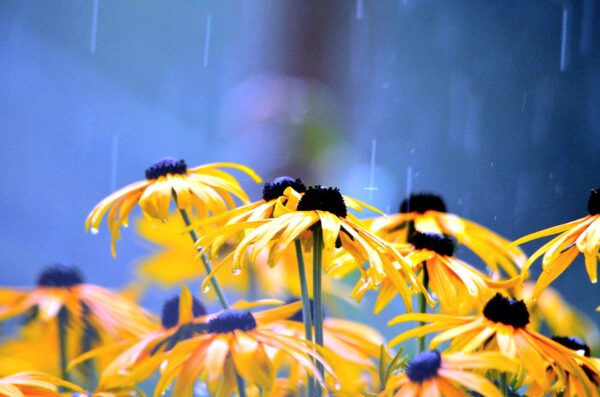
It’s been an interesting weather year. We had that long, cold, wet spring which delayed getting summer crops into the garden. Then like someone turned the sun lamp on we suddenly dove into a long, hot, dry summer which has challenged us all to keep our plants hydrated. Now the transition to autumn is here, with cooler nights, rains ahead of us and the last of our summer veggie harvests happening now. Here is a to do list to focus on for autumn that will help you get ahead of next spring’s gardening season.
- Deeply water trees, shrubs and perennials in your garden. It is best if they go into winter well hydrated and now is a good time to give them a deep drink because they are probably a bit desiccated from the droughty weather. Water as needed depending on the weather and let up when rainfall returns again for the fall and winter. Plants under eaves or on porches will need attention to watering needs through the winter.
- Get ready to plant trees and shrubs, groundcovers too. Planting woody plants in the fall, when the rain returns, is a great idea. Warmer soils encourage plants to establish a good root system, coming rain nourishes them, cooler temps and dormancy enable the plants to focus on root growth and not flowers or leaves, and often you can find good sales going on. Permanent plantings help mitigate stormwater too.
- Stop fertilizing except for a last application on your lawn. For the lawn use a natural ingredient based formulation that releases nutrients slowly. Grass is a cool season crop and will want to grow and reestablish this fall after a hot and dry period.
- Do minimal pruning. Many plants have set buds for next year’s growth already. For instance cutting a rhododendron now is likely to cause you to lose flowers for next spring. Pruning also stimulates growth on the stems and you don’t want your plants sporting tender new leaves when the frost comes. Learn from the experts about how to prune your plants.
- As the weather cools, aerate your lawn and top dress with fresh soil or compost. This will help the lawn recover from the summer and get nutritive materials into the soil, helping to establish a deeper root system. When the rain returns the roots will continue to grow while the soil is warm and establish a good start for next year’s leaf blades.
- Look out for overwintering native bees as you tidy the garden. Plants with hollow stems, dirt banks where bumble bee queens might be sheltering, rock piles and wood piles are all potential overwintering sites and vulnerable to our tidying impulses.
- Also resist trimming all deadheads off annual and perennial flowers now – seeding heads are great for birds looking for food in your garden. For instance Rudbeckia seed heads in the snow will be attractive fare for overwintering birds.
- Check hoses and tools for repair needs and get things fixed before next year or recycle what you cannot use. Check the Seattle public Utilities’ ‘Where Does it Go?’ list for ideas about where to take things. Or here at the King County ‘What Do I Do With?’ site.
- If you have old pesticides (insecticides, herbicides, fungicides, etc) sitting around, make a plan to take them to the Hazardous Waste Management drop off sites so they don’t sit in your garage or basement all winter. Empty containers should be well rinsed and punctured and thrown into the garbage, not recycling bins.
- Growing greens this fall? Slugs and snails are back at it, chomping away on your tender leaves, with the cooling night temperatures. Take care of them by setting slug traps out in your edible garden beds. Fill them with yeast and sugar sweetened water or with beer. They are attracted to the yeast in the beer or yeast water and will climb in and drown. When the container fills with slugs and snails, dig a hole in the garden and bury them and start over. You can also use pieces of boards set on an angle in the garden – slugs will congregate under the boards, especially on a sunny fall day. Then you can gather them and get them out of your veggie beds.
- Get ready to plant garlic and spring flowering bulbs! Get your orders in now so you can get the bulbs for the correct planting time. There are many online sources and local garden centers and our local nurseries are also stocking up.
- Mulch your garden beds. Mulch keeps weeds down and will get ahead of the pesky annual weeds that love cool fall temperatures. Mulch also helps keep moisture in the soil which will help keep your plants hydrated, it protects soil from nutrient loss by breaking up and absorbing rain which might otherwise leach out nutrients. Soil temperatures are also modified by a mulch layer, keeping the soil cooler on a hot day and warmer during the winter. Look for free leaves in your neighborhood and get ahead of leaves clogging storm drains in the street by raking them and using them in your garden beds. Share with your neighbors!
- Grow cover crops in your veggies beds. While you may not be clearing out those tomatoes just yet, you will soon, so get stocked with cover crop seed to plant and protect your soil this winter. Cover crop has the same value as mulching for soil protection but also adds root growth to open up soil, nutrients and organic matter when you dig it in next spring and flowering plants in the spring for early pollinators. It’s a win-win-win!
Enjoy the golden light in the garden this fall while you wind things down – and call us if you have questions. Learn more by following the red live links in this article.